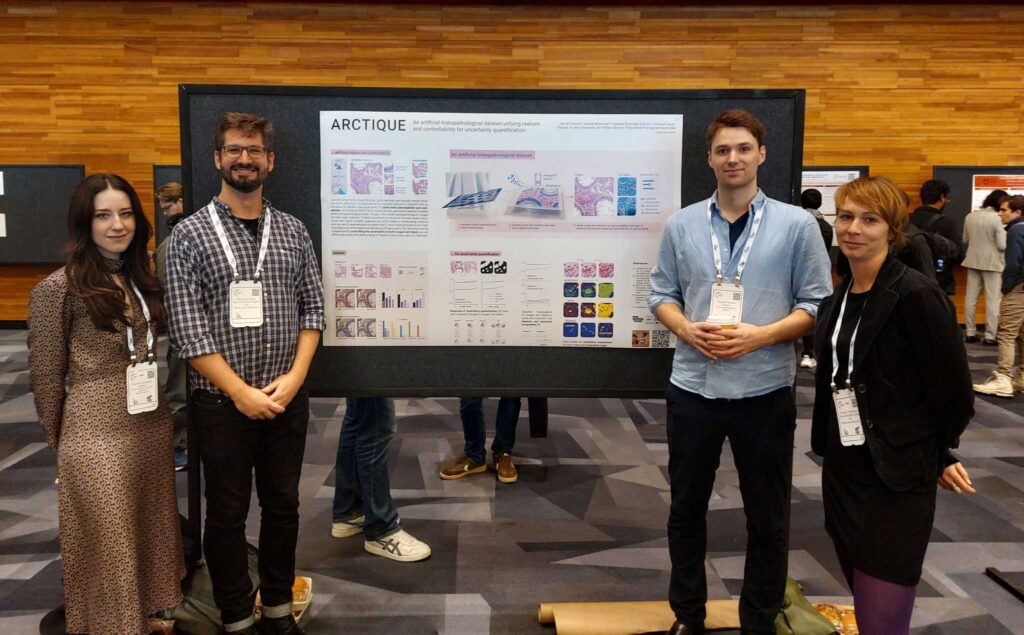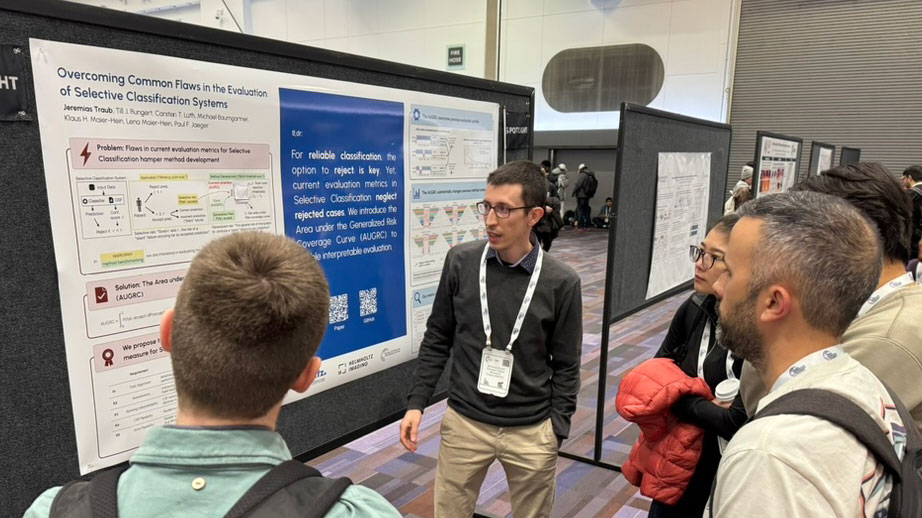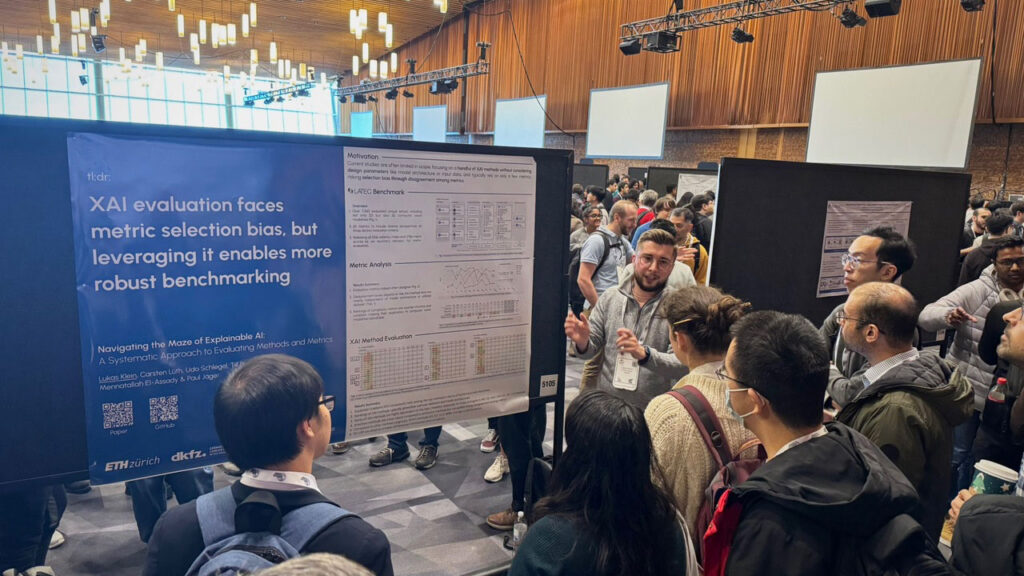Published on 19.12.2024
From Medical Imaging to Explainable AI: Helmholtz Imaging at NeurIPS 2024

The Neural Information Processing Systems (NeurIPS) Conference, a global hub for machine learning and artificial intelligence, took place in Vancouver from December 10 to 15, 2024. Renowned for bringing together leading experts and innovators to share innovative advancements and ideas, NeurIPS is a premier conference in the field. We’re thrilled that this year Helmholtz Imaging made a strong impact, with researchers from the German Cancer Research Center (DKFZ) and the Max Delbrück Center (MDC) showcasing their work through poster and workshop presentations.
Key highlights from our contributions
Poster Presentations

Arctique: An artificial histopathological dataset unifying realism and controllability for uncertainty quantification
Vanessa Emanuela Guarino, Jannik Franzen, Claudia Winklmayr, and Christoph Karg from the Research Unit at MDC unveiled “Arctique: An artificial histopathological dataset unifying realism and controllability for uncertainty quantification.” Arctique is a procedurally generated histopathological dataset for benchmarking uncertainty quantification in medical image segmentation. It provides nearly 50k complex 2D/3D images with perfect ground-truth annotations, cellular metadata, and scene reconstruction variables. With full control over image parameters through intuitive sliders, Arctique enables precise adjustment of noise, complexity, and structure, making it ideal for interpretability studies, robustness testing, and zero-shot learning on H&E data.
Paper (authors: Jannik Franzen, Claudia Winklmayr1, Vanessa E. Guarino, Christoph Karg, Xiaoyan Yu, Nora Koreuber, Jan P. Albrecht, Philip Bischoff, Dagmar Kainmueller)
Code

Overcoming common flaws in the evaluation of selective classification systems
Jeremias Traub and Carsten Lüth presented the Area under the Generalized Risk Coverage curve (AUGRC) metric for a comprehensive, interpretable evaluation of Selective Classification system performance, addressing flaws in existing metrics like Area under Risk Coverage curve. The relevance and effectiveness of the AUGRC is demonstrated through empirical validation across multiple datasets and distribution shifts.
Paper (authors: Jeremias Traub, Till J. Bungert, Carsten T. Lüth, Michael Baumgartner, Klaus H. Maier-Hein, Lena Maier-Hein, Paul Jäger)

Navigating the Maze of Explainable AI: A Systematic Approach to Evaluating Methods and Metrics
Lukas Klein and Carsten Lüth presented “LATEC: A Meta-Evaluation Benchmark for Explainable AI (XAI) Methods and Metrics.” LATEC addresses the challenges of conflicting metrics in evaluating XAI methods, proposing a robust framework for reliable assessment. The team critically analyzed 17 XAI methods across 20 metrics in over 7,500 unique setups, uncovering significant insights, including the emergence of a top-performing method previously unexplored in related studies. This ambitious work sets a new benchmark for evaluating XAI reliability and applicability in diverse computer vision tasks.
Paper (authors: Lukas Klein, Carsten Lüth, Udo Schlegel, Till Bungert, Mennatallah El-Assady, Paul Jäger)
Benchmark
Workshop Presentations
Interactive Semantic Interventions for VLMs: Breaking VLMs with Human Ingenuity
Lukas Klein and Carsten Lüth presented “Interactive Semantic Interventions for VLMs: Breaking VLMs with Human Ingenuity” at the two NeurIPS 2024 Workshops “Statistical Frontiers in LLMs and Foundation Models” and the “Red Teaming GenAI,” an innovative tool for analyzing Vision Language Models (VLMs) to detect and interpret VLM model failures through human interventions on data and context.
Paper (authors: Lukas Klein, Kenza Amara, Carsten T. Lüth, Hendrik Strobelt, Mennatallah El-Assady, Paul Jäger)
Explainable AI-based analysis of human pancreas sections detects traits of type 2 diabetes
At the NeurIPS 2024 Interpretable AI Workshop Lukas Klein and Sebastian Ziegler discussed how they utilize explainable AI (XAI) to analyze pancreatic tissue sections and identify morphological traits associated with Type 2 Diabetes (T2D). By training deep learning models on whole-slide images, it uncovers key biomarkers such as adipocyte infiltration, pancreatic islet alterations, and fibrotic patterns, providing novel insights into T2D pathogenesis and supporting the development of new hypotheses about the disease.
Paper (authors: Lukas Klein, Sebastian Ziegler, Felicia Gerst, Yanni Morgenroth, Karol Gotkowski, Eyke Schöniger, […], Paul Jäger, Fabian Isensee, Michele Solimena, Robert Wagner)
The contributions of our Helmholtz Imaging researchers at NeurIPS 2024 highlight our commitment to applying AI to real-world challenges, from medical imaging to understanding complex models. Congratulations to all participants for their excellent work and valuable insights.